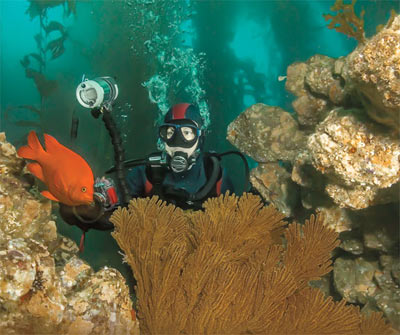About this time of year the weather begins to cool, people begin to think about football and skiing, and many put away their dive gear to gather dust until next spring. Okay, maybe I like to swim upstream, but I love winter diving. It’s not that I dislike football or skiing, but I really like winter diving.
Why you ask? Well, there are two reasons—conditions and marine life.
A miraculous thing happens in Northern California during the fall and winter. The northwesterly winds wane and the water gets flat. In the absence of upwelling the water warms a bit and the visibility reaches its yearly best.
Beaches are often sunny and uncrowded since the tourists have long since departed. Frequently, the warmest days I have spent on the beach in Nor Cal have been during December and January. Yes, the diving may be a bit unpredictable since California does get a some big storms during the winter months, but the calm period between storms produces the best visibility of the entire year. In fact, the vast majority of the wide-angle photos I acquire each year are shot during the winter months.
Also, some marine life and behavior may only be observed in winter. For instance, gray whales migrate south during December through February, and back north during April through May. This is high season for whale watching companies and divers can get their chance at in-water encounters. While it is illegal to chase whales, there are a few spots where they choose to approach divers. Cypress Point and Eric’s Pinnacle are two good places along with the area between Monastery Beach and Copper Roof House. The latter is better during the northerly migration. While even at these locations the chances of an in-water encounter is low, it will never happen if you’re not in the water.
Other less spectacular events happen only in the winter. Both lingcod and cabezon nest during the winter. In both species the males guard the nests and their behavior allows great opportunities for up close and personal fish portraiture. Point Lobos State Reserve is a good place to view and photograph these fish.
Leopard sharks also move inshore to shallow bays during late winter. These sharks are live bearers and seek out calm waters for there newborn. Point Lobos, Lovers Point, and Carmel Meadows are good places to look for leopard sharks.
For those seeking real adventure, great white sharks may be found at their winter feeding grounds. Northern elephant seals congregate on several Nor Cal beaches to give birth and mate from October through February, and the big sharks always show up to dine on the fat seals. The Farallon Islands, Point Reyes, Año Nuevo State Reserve, and the beaches near San Simeon are good places to view both elephant seals and white sharks. (There are rules on how and where sharks may be attracted. You will need to look into these if you want to dive in cages with sharks.)
And, the list goes on. Remember, you’ll miss all of the unusual winter marine life and behavior if you don’t get out and get wet. So watch the weather and pick your days carefully, but do dive this winter.










